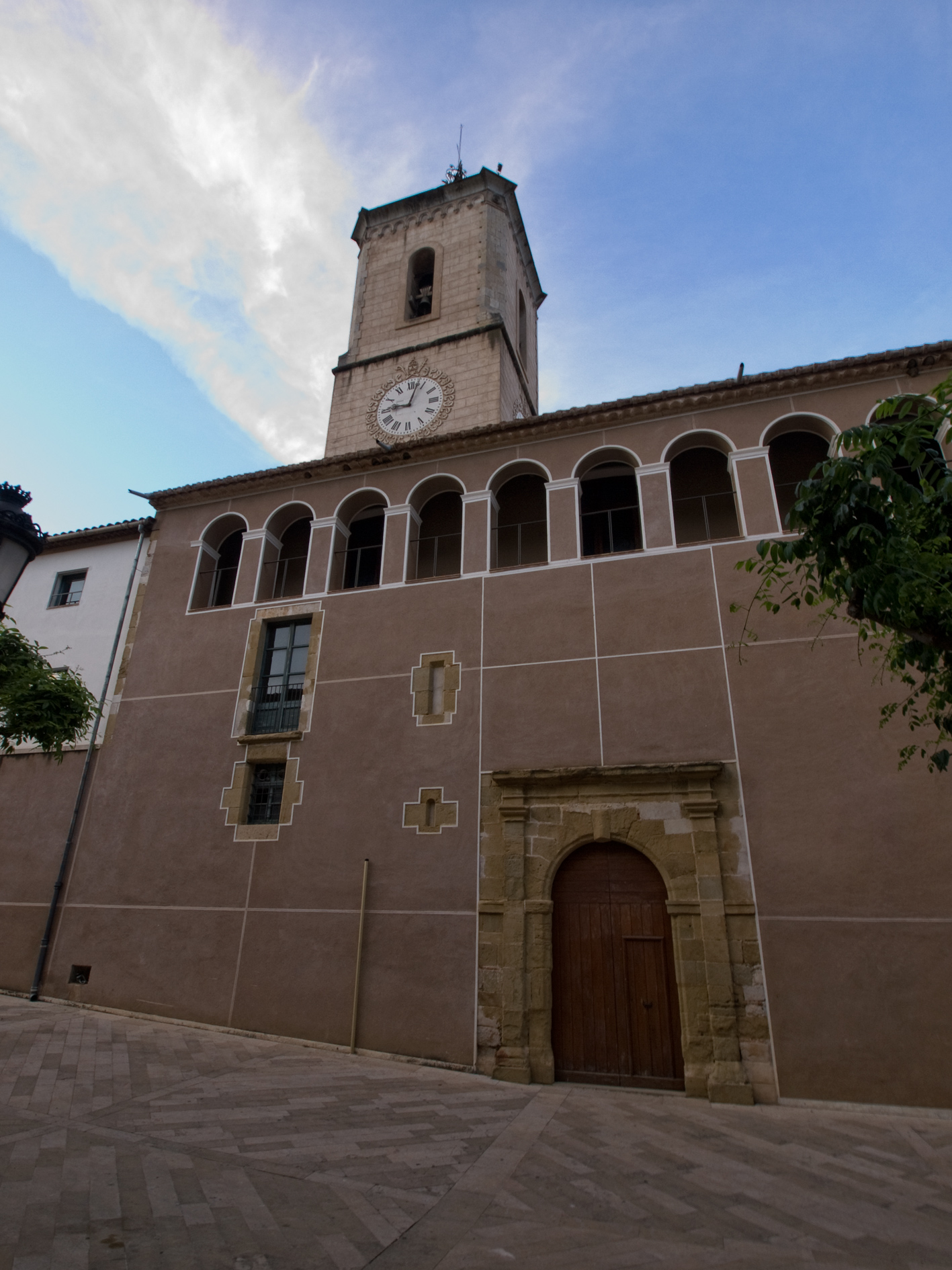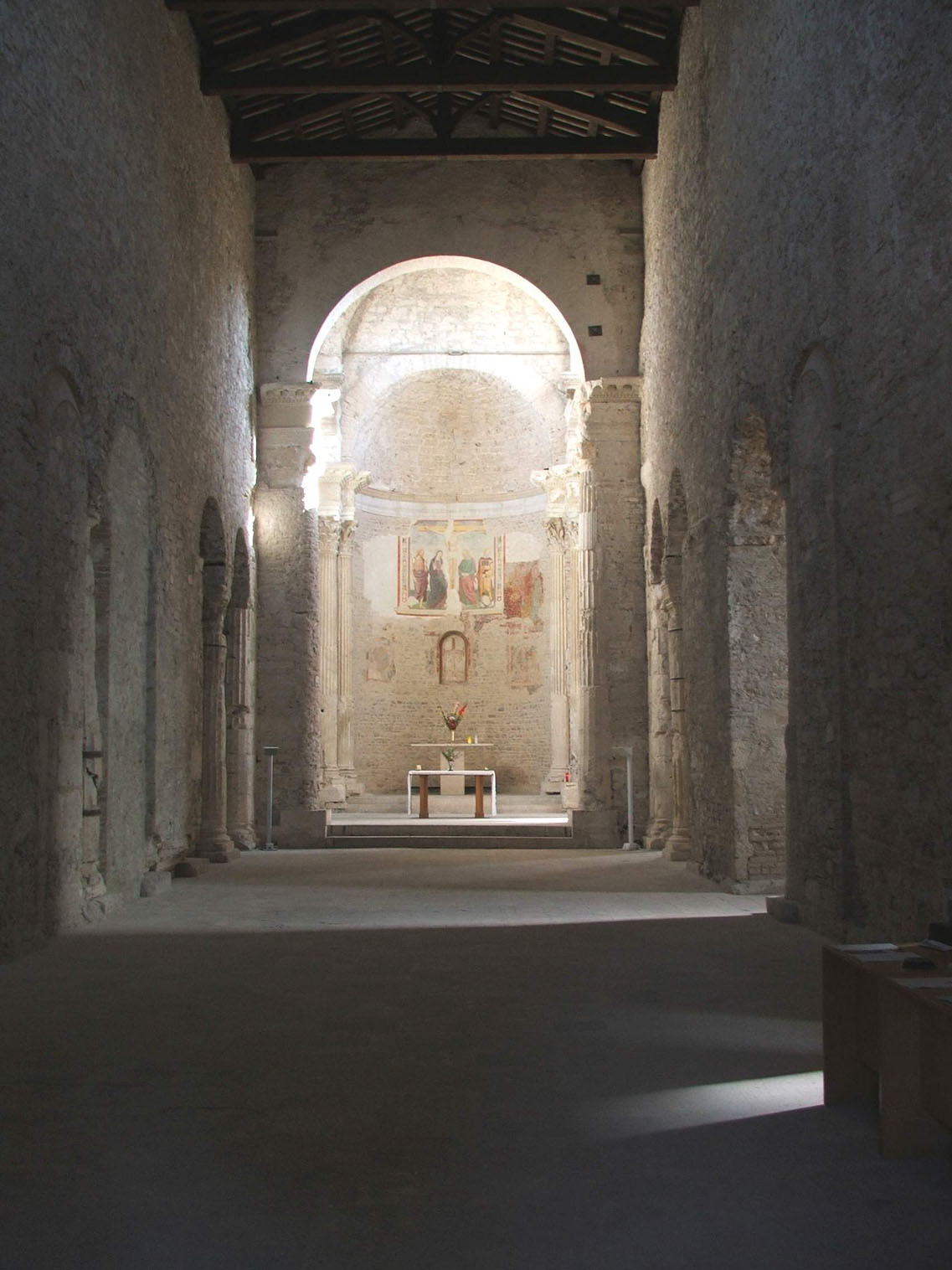|
Santa Maria De Roses
Santa Maria de Roses is a ruined Benedictine monastery in the municipality of Roses, Alt Empordà comarca, Catalonia, Spain. It is situated within the Ciutadella de Roses, a fortification in the Province of Girona. It is the earliest known example of Lombard architectural style in the country. History The origin of this monastery is in a church, Santa Maria de Rodes, belonging to the Monastery of Sant Pere de Rodes. The monastic activity was affected repeatedly by attacks from Saracen pirates. In 960, the monastic community received protection Gausfred I, Count of Ampurias and Roussillon. In 976, it received fishing rights as well as shipwreck rights in local waters and for various goods. A foundation charter dates to 1022. There were several subsidiaries such as Santa Maria de Pedardell and Santa Maria del Camp. The monastery began to decline in the 15th century. In 1588, because of a plague epidemic, the monastic houses were abandoned and the monastery was looted. In 1592, by p ... [...More Info...] [...Related Items...] OR: [Wikipedia] [Google] [Baidu] |
Saracen
upright 1.5, Late 15th-century German woodcut depicting Saracens Saracen ( ) was a term used in the early centuries, both in Greek and Latin writings, to refer to the people who lived in and near what was designated by the Romans as Arabia Petraea and Arabia Deserta. The term's meaning evolved during its history of usage. During the Early Middle Ages, the term came to be associated with the tribes of Arabia. The oldest known source mentioning "Saracens" in relation to Islam dates back to the 7th century, in the Greek-language Christian tract ''Doctrina Jacobi''. Among other major events, the tract discusses the Muslim conquest of the Levant, which occurred after the rise of the Rashidun Caliphate following the death of the Islamic prophet Muhammad. The Roman-Catholic church and European Christian leaders used the term during the Middle Ages to refer to Muslims—usually Arabs, Turks, and Iranians. By the 12th century, "Saracen" had become synonymous with "Muslim" in Medieva ... [...More Info...] [...Related Items...] OR: [Wikipedia] [Google] [Baidu] |
Benedictine Monasteries In Catalonia
, image = Medalla San Benito.PNG , caption = Design on the obverse side of the Saint Benedict Medal , abbreviation = OSB , formation = , motto = (English: 'Pray and Work') , founder = Benedict of Nursia , founding_location = Subiaco Abbey , type = Catholic religious order , headquarters = Sant'Anselmo all'Aventino , num_members = 6,802 (3,419 priests) as of 2020 , leader_title = Abbot Primate , leader_name = Gregory Polan, OSB , main_organ = Benedictine Confederation , parent_organization = Catholic Church , website = The Benedictines, officially the Order of Saint Benedict ( la, Ordo Sancti Benedicti, abbreviated as OSB), are a monastic religious order of the Catholic Church following the Rule of Saint Benedict. They are also sometimes called the Black Monks, in reference to the colour of their religious habits. They wer ... [...More Info...] [...Related Items...] OR: [Wikipedia] [Google] [Baidu] |
Basilica
In Ancient Roman architecture, a basilica is a large public building with multiple functions, typically built alongside the town's forum. The basilica was in the Latin West equivalent to a stoa in the Greek East. The building gave its name to the architectural form of the basilica. Originally, a basilica was an ancient Roman public building, where courts were held, as well as serving other official and public functions. Basilicas are typically rectangular buildings with a central nave flanked by two or more longitudinal aisles, with the roof at two levels, being higher in the centre over the nave to admit a clerestory and lower over the side-aisles. An apse at one end, or less frequently at both ends or on the side, usually contained the raised tribunal occupied by the Roman magistrates. The basilica was centrally located in every Roman town, usually adjacent to the forum and often opposite a temple in imperial-era forums. Basilicas were also built in private residences an ... [...More Info...] [...Related Items...] OR: [Wikipedia] [Google] [Baidu] |
Volta Santa Maria De Roses
Volta may refer to: Persons * Alessandro Volta (1745–1827), Italian physicist and inventor of the electric battery, count and eponym of the volt * Giovanni Volta (1928–2012), Italian Roman Catholic bishop * Giovanni Serafino Volta (1764–1842) Italian priest, naturalist and paleontologist * Massimo Volta (born 1987), Italian footballer *Leopoldo Camillo Volta (1751–1823) Italian librarian and historian of Mantua Places * Volta, California, a census-designated place in Merced County, California, US * Volta Mantovana, an Italian municipality in the Lombardy region * Porta Volta, a former city gate of Milan, Italy * Volta Grande, a Brazilian municipality in the Minas Gerais state * Volta Redonda, a Brazilian municipality in the Rio de Janeiro state * Upper Volta (other) * Lake Volta, in Ghana * Volta Region, in Ghana * Volta River, primarily flowing in Ghana, with its headstreams: ** White Volta ** Red Volta ** Black Volta * Volta (crater), a crater on the moon * 820 ... [...More Info...] [...Related Items...] OR: [Wikipedia] [Google] [Baidu] |
Porta De Santa Maria De Roses
Porta can refer to: People * Porta (rapper) (born 1988), stagename of Christian Jiménez Bundo, a Spanish rap singer * Bernardo Porta (1758–1829), Italian composer active in France * Bianca Della Porta (born 1991), Canadian ice hockey and rugby player * Carlo Porta (1775–1821), Italian poet in the Milanese dialect * Costanzo Porta (1528–1601), Italian composer of the Renaissance * Giacomo della Porta (1532–1602), Italian sculptor and architect * Giambattista della Porta (1535–1615), Neapolitan physician and playwright * Giovanni Porta (1675–1755), Italian composer * Hugo Porta (born 1951), Argentine rugby union footballer * Livio Dante Porta (1923–2003), Argentine engineer * Luigi Porta (1800–1875), Italian surgeon * Miquel Porta (born 1957), Spanish epidemiologist and scholar * Richard Porta (born 1983), Uruguayan Australian footballer Places * La Porta, a commune in the Haute-Corse department of France on the island of Corsica * Porta (Barcelona) a neighbourhoo ... [...More Info...] [...Related Items...] OR: [Wikipedia] [Google] [Baidu] |
Santa Maria D'Amer
Santa Maria d'Amer is a Benedictine monastery in Amer, Selva, Catalonia, Spain. History The monastery was founded in 820 by the abbot Deodat and initially was devoted to Saint Medir and Saint Genís. King Louis the Pious granted an immunity provision to the monastery which was confirmed by Charles the Bald in 844 and in 860. In 949, it moved to a new location within Amer. Rebuilt and consecrated, it was dedicated to St. Mary. The monastery gained in importance and grew in assets in the following centuries. Although he was linked with the Roman Catholic Diocese of Girona, during the 11th and 12th centuries, it remained independent. In the 12th century, it was amended again and the priory church of Santa Maria de Cóll was founded. In 1381, the jurisdiction of the Amer religious community was left to the monastery. In 1445, it was associated for a brief period with the monastery of Sant Pere de Galligants. In 1592, by papal order, it was attached to the monastery of Santa Maria d ... [...More Info...] [...Related Items...] OR: [Wikipedia] [Google] [Baidu] |
Gausfred I
Gausfred I (died 991) was the count of Empúries and Rosselló from 931 until his death. He was the son and successor of Gausbert. He spent his whole life consolidating his authority in his counties, but he divided the realm amongst his sons. By his testament of 989, Empúries and Perelada went to Hugh and Roussillon went to Giselbert.“Gausfred I d’Empúries-Rosselló” '' Gran Enciclopèdia Catalana'' (in Catalan) He married firstly Ava Guisla, probably the daughter of Raymond II, |
Sant Pere De Rodes
Sant Pere de Rodes () is a former Benedictine monastery in the comarca of Alt Empordà, in the North East of Catalonia, Spain. Location Located in the municipal area of El Port de la Selva in the province of Girona, Spain, it was built on the slope of the Verdera Mountain, just below the Castle of Sant Verdera, which provided protection for the monastery but now lies in ruins at the very summit. It offers exceptional views over the bay of Llançà, to the north of Cap de Creus. Near the monastery Santa Creu de Rodes are the ruins of a medieval town, of which its pre-Romanesque-style church dedicated to Saint Helena is all that remains. File:Castell de Sant Salvador El Port de la Selva.jpg, Verdera Castle (inset: north tower). File:Santa Helena church.jpg, Santa Helena church, and remains of the medieval settlement at Santa Creu de Rodes. History The true origin of the monastery is not known, which has given rise to speculation and legend; such as its foundation by monk ... [...More Info...] [...Related Items...] OR: [Wikipedia] [Google] [Baidu] |
Benedictine
, image = Medalla San Benito.PNG , caption = Design on the obverse side of the Saint Benedict Medal , abbreviation = OSB , formation = , motto = (English: 'Pray and Work') , founder = Benedict of Nursia , founding_location = Subiaco Abbey , type = Catholic religious order , headquarters = Sant'Anselmo all'Aventino , num_members = 6,802 (3,419 priests) as of 2020 , leader_title = Abbot Primate , leader_name = Gregory Polan, OSB , main_organ = Benedictine Confederation , parent_organization = Catholic Church , website = The Benedictines, officially the Order of Saint Benedict ( la, Ordo Sancti Benedicti, abbreviated as OSB), are a monastic religious order of the Catholic Church following the Rule of Saint Benedict. They are also sometimes called the Black Monks, in reference to the colour of their religious habits. They ... [...More Info...] [...Related Items...] OR: [Wikipedia] [Google] [Baidu] |
Lombard Architecture
Lombard architecture refers to the architecture of the Kingdom of the Lombards, which lasted from 568 to 774 (with residual permanence in southern Italy until the 10th–11th centuries) and which was commissioned by Lombard kings and dukes. The architectural works of the Lombards in northern Italy (Langobardia Major) have been mostly lost due to later renovations or reconstructions, the few exceptions including the Tempietto longobardo at Cividale del Friuli or the Church of Santa Maria foris portas at Castelseprio. More examples have instead survived in southern Italy ( Langobardia Minor), especially in what was the Duchy of Benevento: they include the city's walls, the church of Santa Sofia and the Rocca dei Rettori, one of the few surviving Lombard military structures, as well as other minor sites near Benevento and in the former duchy of Spoleto. The main surviving examples of Lombard architecture have been included in the Longobards in Italy: Places of Power (568–774 A.D ... [...More Info...] [...Related Items...] OR: [Wikipedia] [Google] [Baidu] |
Province Of Girona
Girona (; es, Gerona ; french: Gérone) is a province of Spain, in the northeastern part of the autonomous community of Catalonia. It is bordered on the northwest by the province of Lleida, on the southwest by the province of Barcelona, on the north by France ( Pyrénées-Orientales), and on the east by the Mediterranean Sea. The population of the province in 2016 was 739,607. Its capital and largest city is Girona, with an urban area (including the neighbouring municipalities of Salt, Sarrià de Ter and Vilablareix) representing, with a total population of 144,709, 19.2% of the population. The Girona area acts as an industrial, commercial and service hub for a significant part of the province. Municipalities of Girona The province has 222 municipalities, including Girona city (population 96,722), Figueres (pop. 44,765), Lloret de Mar (pop. 40,282), Blanes (pop. 39,834), Olot (33,725), Salt (pop. 30,389), Palafrugell (pop. 22,816) and Sant Feliu de Guíxols (pop. 21,814), as ... [...More Info...] [...Related Items...] OR: [Wikipedia] [Google] [Baidu] |






